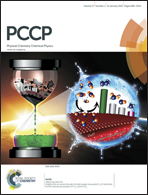Molecular charge transfer by adsorbing TCNQ/TTF molecules via π–π interaction: a simple and effective strategy to modulate the electronic and magnetic behaviors of zigzag SiC nanoribbons†
Abstract
By means of first-principles computations, we first propose a simple and effective strategy through the molecular charge transfer via noncovalent π–π interaction to modulate the electronic and magnetic properties of zigzag SiC nanoribbons (zSiCNRs). This charge transfer is induced by adsorbing the electron-withdrawing/donating tetracyanoquinodimethane (TCNQ) or tetrathiafulvalene (TTF) molecules on the surface of the pristine zSiCNR. It is revealed that all the TCNQ- and TTF-modified zSiCNR-systems can exhibit considerable adsorption energies in the range from −137.2 to −184.0 kJ mol−1 and from −71.3 to −76.9 kJ mol−1, respectively, indicating that these zSiCNR-complexes possess high structure stabilities. This kind of a molecular charge transfer via π–π interaction can break the magnetic degeneracy of zSiCNRs, and the sole ferromagnetic (FM) metallicity and even antiferromagnetic (AFM) half-metallicity can be achieved. These intriguing findings will be advantageous for promoting SiC-based nanomaterials in the application of spintronics and multifunctional nanodevices in the near future.


 Please wait while we load your content...
Please wait while we load your content...